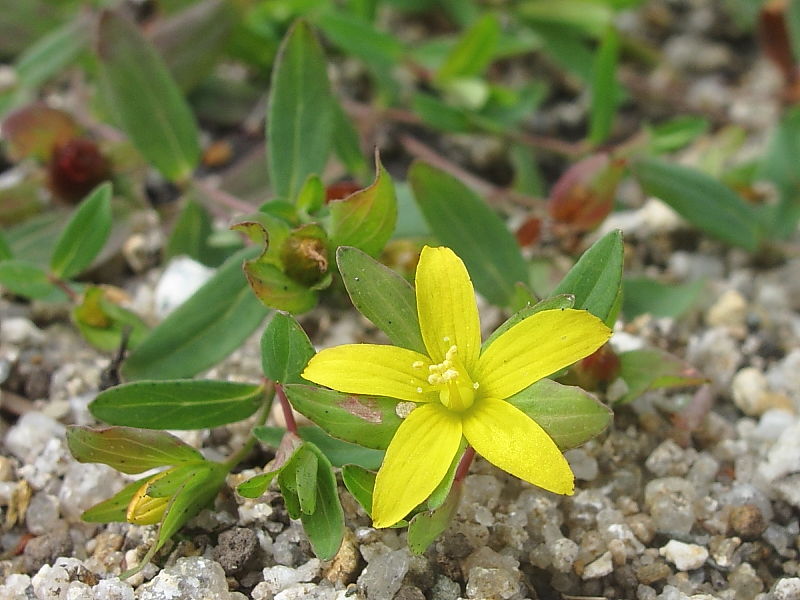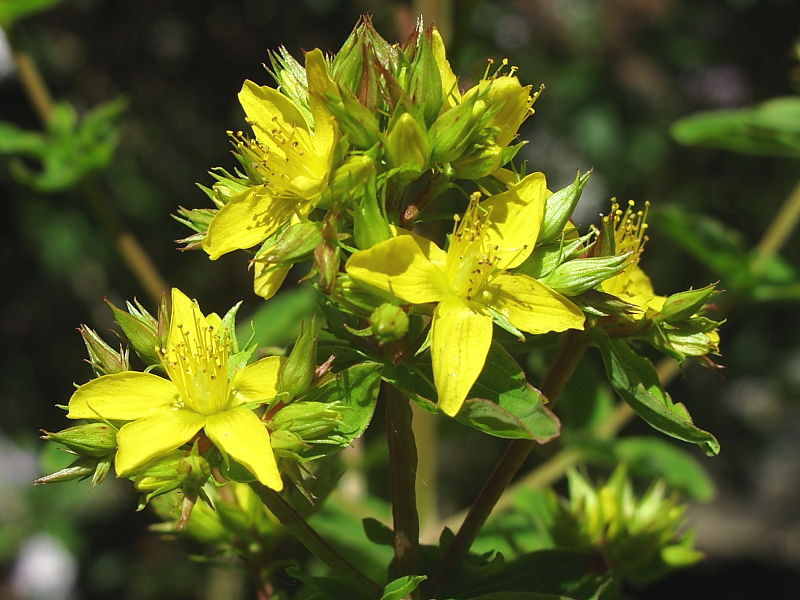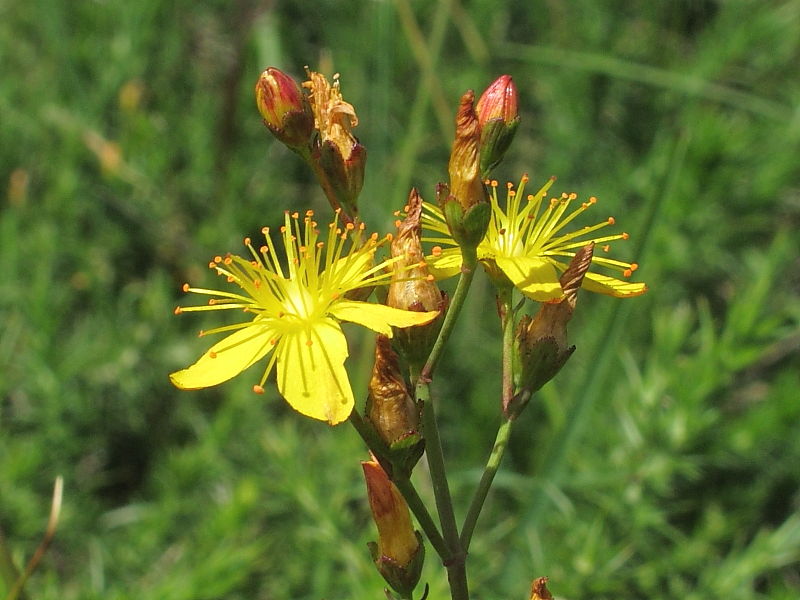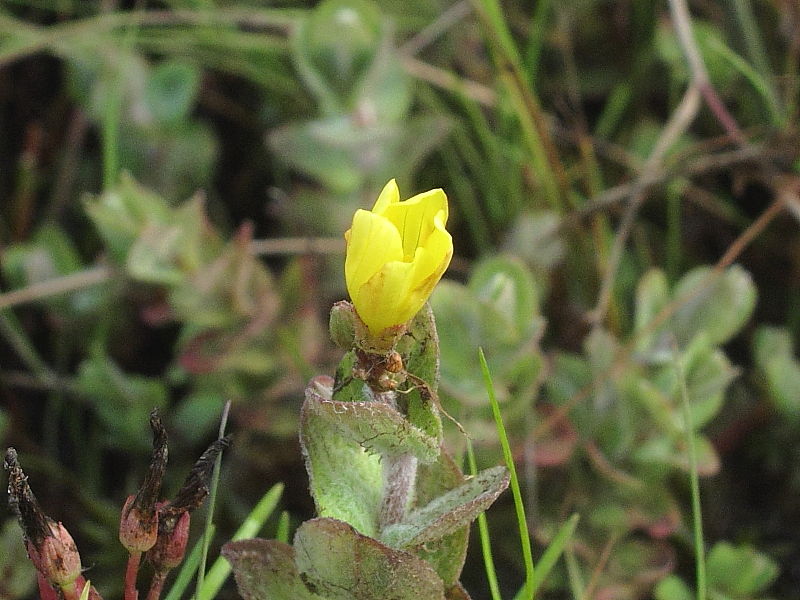Introduction to British St John’s-worts (Hypericaceae)
Hypericaceae is a family of distinctive annual or perennial herbs or shrubs. It was formerly considered a sub family of Clusiaceae.
The leaves are opposite, untoothed, stalkless, simple and with translucent veins. The flowers are in branched cymes (except Rose-of-Sharon (Hypericum calycinum) where they are solitary) and yellow with 5 sepals, 5 petals and many stamens. The fruit is a capsule or berry-like.
The things to look for to identify Hypericums are stem shape (whether round or square or with ridges), whether the leaves are hairy or not, whether the leaves have translucent white dots when held up to the light and the length of sepals in relation to petals as well as the presence or absence of black dots on the leaves, sepals and petals.
Many of the members of the Hypericaceae family are common and distributed throughout Britain whilst others are very local (Wavy St John’s-wort (Hypericum undulatum) found in south west England and west Wales) or very rare (Toadflax-leaved St John’s-wort (Hypericum linariifolium) only found in south Devon, west Wales and the Channel Islands).
Most St John’s-worts are native to Britain but there are two that were introduced in the 17th century: Rose-of-Sharon (Hypericum calycinum) a native of Turkey and Stinking Tutsan (Hypericum hircinum) a native of the Mediterranean.
The common St John’s-worts flower from June to August/September.
The flowers of some St John’s-worts are a larval foodplant for a number of species of moth such as V-Pug (Chloroclystis v-ata), Bright-line Brown-eye (Lacanobia oleracea) and Mottled Beauty (Alcis repandata).
Key identification characteristics for the more common members of the St John’s-worts family found in Britain are given below.
Rose-of-Sharon (Hypericum calycinum)
The key identification characteristics of Rose-of-Sharon (Hypericum calycinum) are:
- shrubby plant
- stems woody
- creeping woody rhizome
- 5 styles
- petals larger than 20mm
- evergreen leaves
Tutsan (Hypericum androsaemum)
The key identification characteristics of Tutsan (Hypericum androsaemum) are:
- shrubby plant
- stems woody
- plant not rhizomatous
- 3 styles
- petals less than 15mm
- leaves often scented but not smelling of goats*
*This may seem like a weird identification key but if the petals were 15 to 20mm and the leaves did smell strongly of goats when crushed then the plant would be Stinking Tutsan (Hypericum hircinum).
Trailing St John’s-wort (Hypericum humifusum)
The key identification characteristics of Trailing St John’s-wort (Hypericum humifusum) are:
- plant not shrubby and stems not woody except maybe at the base
- stems glabrous, leaves glabrous or only sparingly hairy beneath
- stems with 2 ridges
- stems slender and prostrate
- petals less than twice as long as sepals
Perforate St John’s-wort (Hypericum perforatum)
The key identification characteristics of Perforate St John’s-wort (Hypericum perforatum) are:
- plant not shrubby and stems not woody except maybe at the base
- stems glabrous
- leaves glabrous or only sparingly hairy beneath
- stems with 2 ridges
- flowering stems erect
- petals twice as long as sepals or more
- sepals entire*
*If all the other identification characteristics were the same but the sepals were fringed with black glands then instead the plant would be Toadflax-leaved St John’s-wort (Hypericum linariifolium) but this is only found rarely in west Wales, south west England and the Channel Islands whereas Perforate St John’s-wort is common throughout the British Isles.
Square-stalked St John’s-wort (Hypericum tetrapterum)
The key identification characteristics of Square-stalked St John’s-wort (Hypericum tetrapterum) are:
- plant not shrubby and stems not woody except maybe at the base
- stems glabrous, leaves glabrous or only sparingly hairy beneath
- stems with 4 ridges and square in cross-section
- petals less than twice as long as sepals
- stems 30-70cm and firm
- leaves with black glandular dots
- petals pale yellow
- flowers 10mm across or more
Slender St John’s-wort (Hypericum pulchrum)
The key identification characteristics of Slender St John’s-wort (Hypericum pulchrum) are:
- plant not shrubby and stems not woody except maybe at the base
- stems glabrous, leaves glabrous or only sparingly hairy beneath
- stems smooth with no ridges
- leaves 5-10mm and glabrous beneath
Marsh St John’s-wort (Hypericum elodes)
The key identification characteristics of Marsh St John’s-wort (Hypericum elodes) are:
- plant not shrubby and stems not woody except maybe at the base
- stems and leaves conspicuously hairy
- bog plant rooting at nodes
- leaves rounded and woolly
- edge of sepals with red glands
This looks quite unlike other Hypericum species and is the only hairy one with rooting nodes.
The wild flower gallery has images of other wild flowers in Britain shown by family.





